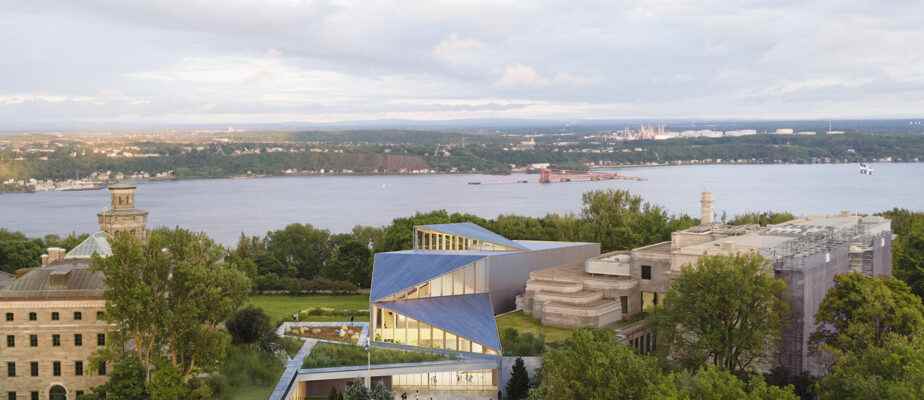After several weeks of deliberation, the Musée national des beaux-arts du Québec (MNBAQ) has finally announced the winner of its architectural competition for the future Espace Riopelle: the FABG architects. A Montreal group that has “extensive experience in creating cultural spaces”.
Posted at 8:00 a.m.
Well known in the metropolis and its surroundings, the firm founded more than 60 years ago is actually behind the concept of many cultural places such as the Verdun Auditorium, the Quat’Sous theater, the Museum of art of Joliette, the Biosphere or the head office of Cirque du Soleil.
Éric Gauthier, principal partner of FABG Architects, will sign the first achievement of his firm in Quebec. A project that he welcomes with “great joy”.
“It’s quite rare, museum institutions devoted to a single artist. A museum, normally, is a somewhat neutral space, like a performance hall. The works move and change.
“There, we must evoke the presence of Riopelle, so that his creations resonate in this place. I have already seen his paintings in museums and sometimes I had the impression that we were losing the essence of his paintings in a very clean space, “says the graduate of the School of Architecture at Laval University. , interviewed at Sun.
According to the MNBAQ, FABG’s projections concerning Espace Riopelle particularly charmed the jury because of “the quality of its thinking”, “the intelligence of the concept developed” and “the originality of the solutions proposed to redefine the MNBAQ museum complex in order to offer the public a more fluid and contemplative overall experience”.
In order to imagine the future Espace Riopelle, Éric Gauthier and his team were particularly inspired by the painter’s studio, which evokes “nordicity, the landscapes of L’Île-aux-Grues”.
We tried to integrate several elements that make people, during their visit, feel halfway between the chalet, the studio where the works were painted and the museum institution.
Éric Gauthier, senior partner at FABG Architects
Nature and territory, themes intrinsic to Riopelle’s creations, thus mark the concept.
A building bathed in light
Even if the pavilion is called upon to be modified somewhat during the “integrated design process”, the structure should, thanks to large glass walls, be bathed in natural light and give a direct view of the St. Lawrence River.
The Espace Riopelle is therefore designed as an “ascending journey” whose culmination will ultimately lead the public to the circular room dedicated to Tribute to Rosa Luxemburg (1992), an immense work made up of 30 paintings.
“Visitors will go up from one floor to another, towards Tribute to Rosa Luxemburg. The building reflects this effect. The roofs form triangles, an impetus towards this work,” explains Éric Gauthier, who won the 2017 Ernest-Cormier Prize, the highest distinction given to an individual for his entire career in the field of architecture.

PHOTO FABG, PROVIDED BY THE MNBAQ
The room dedicated to Tribute to Rosa Luxemburg will be the highest in the building. Drone tests have been carried out to assess the height at which visitors will have the best view of the St. Lawrence River.
The Espace Riopelle will therefore serve as a showcase for the world’s largest public collection of works by Jean Paul Riopelle… but not only.
For Jean-Luc Murray, Director General of the MNBAQ, this new building will become “the cornerstone” of the entire museum complex in order to better connect the different pavilions with each other.
If the Lassonde, on Grande-Allée, allowed the organization to make a move towards the street, to meet the community, it nevertheless created a less logical route for visitors parading through the tunnels.
We want to link the Lassonde pavilion to the national collection. It is a strong gesture for us which allows us to affirm our identity. There will be better fluidity.
Jean-Luc Murray, general manager of the MNBAQ
“Beyond making a great project for Riopelle, this proposal [de FABG] brought other opportunities. We are therefore very happy to kill several birds with one stone,” explains Mr. Murray, who sat on the jury alongside four architects and Manon Gauthier, Executive Director of the Jean Paul Riopelle Foundation.
This improvement of the “visitor experience” was also part of the constraints to be respected within the framework of the architectural competition. A point on which FABG architects have particularly distinguished themselves, notes the director general of the MNBAQ.
According to him, the Espace Riopelle will therefore be an “elegant building” and distinctive, which will be able to integrate with the other styles of the Charles-Baillairgé and Gérard-Morisset pavilions.

PHOTO FABG, PROVIDED BY THE MNBAQ
With its unique architecture, Espace Riopelle will link all the other pavilions together and create an intuitive journey for visitors.
According to Jean-Luc Murray, the next few months will thus be devoted to the integrated design process and to the “preparatory phases of the construction work”.
In addition to redeveloping its workspaces, the museum will try to present the project to the community and its partners. Whether we are talking about the inhabitants of the Montcalm district, the school community or the team from the National Battlefields Commission. The MNBAQ wishes to offer an “accessible and inclusive” place to visitors.
The closure of the Gérard-Morisset pavilion is scheduled for January 2023. With the Charles-Baillairgé building closed since April 2022, this therefore means that the MNBAQ will only operate the Lassonde pavilion until the fall of 2025, during the inauguration of the Espace Riopelle.
A dynamic program will however be offered to the public, assures Mr. Murray.
